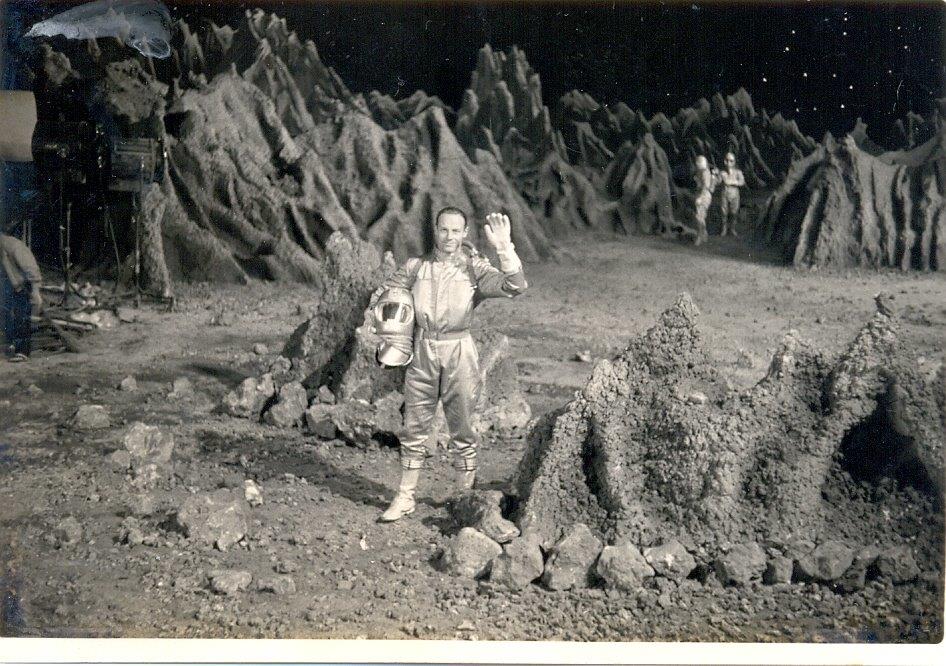
Heinz Bodmer sets foot on the Moon 10 years before the crew of Apollo 11 in Battle in Outer Space (1959). Photo © Heinz Bodmer. Battle in Outer Space © 1959, Toho Co., Ltd.
Battle in Outer Space (1959) remains a popular entry in Toho’s special effects films series, and given the sheer number of foreign talent used in the film, it’s a rather unusual one. One such player is Heinz Bodmer, who appeared in the movie as a SPIP crew member who travels to the Moon to do battle with the evil Natal aliens.
Born on December 12, 1934, Heinz Bodmer came to Japan from Switzerland in the late 1950s and stayed much longer than he originally anticipated. One reason is that he quickly discovered that he could make extra money, working in the movies as an extra. Throughout the late 1950s and early ‘60s, Mr. Bodmer appears in numerous films made by Toho, Nikkatsu, and Shintoho. Brett Homenick spoke to Mr. Bodmer about his career as an extra in Japanese films.
Brett Homenick: Please tell me a little about your background.
Heinz Bodmer: I was born in Switzerland, near Zurich. I graduated (from) high school there. I served an apprenticeship as a precision machinist.
BH: During that time, what did you think you would ultimately do as a career?
HB: I seem to have always had the idea about going to see the world, not staying in little Switzerland. So, after I finished my apprenticeship, I took a job. I also started to learn judo. After I had saved up enough money, I decided I was going to go to Japan and go to the original Kodokan, the original judo school where judo was developed and practice judo there and learn more of it. I also wanted to learn karate and did so at the Shotokan Karate School in Tokyo. Eventually, I ended up with a 3rd-degree black belt in judo and a 2nd-degree black belt in karate.
I had saved up enough money to spend about 10 months in Japan. I also had enough money, of course, to buy a roundtrip ticket on a boat from Marseilles, France, to Yokohama, Japan. That trip took about 33 days. So I was going to be one month going there, 10 months practicing judo and karate there, and then one month back. But that’s not how it turned out because I found out that I could make money in Japan by teaching languages and by being an extra in the movies. So 10 months became almost three years.
BH: Do you remember the date, more or less, when you came to Japan?
HB: At the beginning of 1958. Instead of going back to Switzerland, I kept right on going across the Pacific and ended up in Mexico where I taught judo and karate. Then I spent some time in Costa Rica, and eventually I ended up in California, USA. That was all after Japan.
BH: Going back to Japan, when you arrived there, you mentioned you realized that you could teach language and so forth and be there much longer than 10 months. Around what time did you make the decision that you would stay there rather than just be there for the 10 months?
HB: I think as soon as I realized I didn’t have to spend my savings, as soon as I realized I could make a living, that’s when I decided I was going to stay longer. (I made my decision) in Japan. I was there about a month or two, and I realized I could teach languages. About a month thereafter, I found out that I could be an extra in the movies and make even more money. Of course, I decided there was no sense in me leaving after 10 months, and I realized that I was on a student visa, and I realized I could extend it twice for a total of three years. That’s what I did.
After extending that visa twice, I would have had to leave Japan and go back in if I wanted to stay longer. Some of my friends at the judo school, they would go to Hong Kong and get a new student visa and then get back into Japan. But, after three years there, or just short of three years, I decided I needed to move on.
BH: What part of Tokyo did you live in?
HB: Oh, I lived in several places. I lived near the judo school. I forgot the name of the area. It may have been Bunkyo-ku. But from there I lived in Shinjuku and later on in Shinagawa and then in Iidabashi.
BH: How did you find out that you could be an extra in movies?
HB: An American guy by the name of Don Droeger – I met him at the judo school. He asked me one day, “You want to make some money?” I said, “Yeah, how?” He explained (it) to me, and he said he had a friend down at the Ginza who had an office, and next time he’d go down there, he’d take me along to take a picture of me and put it in an album. When the movie people wanted somebody that looked like me, they’d call me. So it happened. I got called again and again and again.
BH: Was that Johnny Yusuf?
HB: No, that was an American guy, but I forgot his name.
BH: Ed Keane?
HB: Yeah, Ed Keane. Yes! (laughs) But Yusuf was my agent thereafter. He was the one who would call me and meet me and whoever else took those jobs. He’d be at whichever studio we had to go to. Sometimes Yusuf himself would take a little job as an extra or a big part because he was fluent in Japanese. He got to Japan when he was a kid. He was probably about 40 years old or so. Anyway, he had been in Japan for a long time, and he was fluent. So he could get parts in the movies, actual parts.
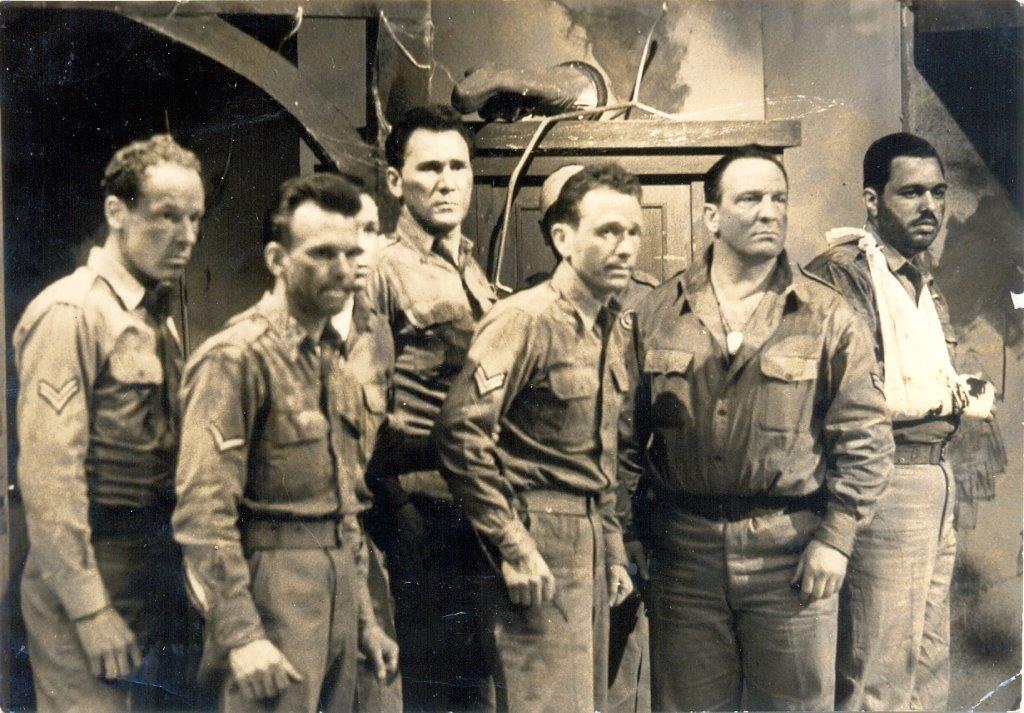
Heinz Bodmer (on the far left) as a POW in a TV drama. Johnny Yusuf is fourth from the left. Photo © Heinz Bodmer.
BH: What do you remember about Ed Keane and even Johnny Yusuf on personal level or even on a professional level?
HB: Ed Keane, I just met him that one time when I went down there to his office where they took my picture. After that, I had no more business or connection with Ed Keane.
(Yusuf) was a super-nice guy; I liked him a lot. When he would call me, like when they needed a couple for a nightclub scene or something like that where you’d sit at a table drinking colored water, conversing and sometimes get up and dancing, or watching some performance, he’d always ask me, “Who do you want me to call to be your date or your wife?” And I could choose. I’d tell him, “Oh, call this one or that one.” He’d oblige, so I liked him a lot! (laughs)
BH: (laughs) Who did you usually recommend as your date?
HB: Well, that of course changed overtime, but one of them that I chose often because I liked her a lot, was Dona Carlson. She and her boy, who was about eight or nine, I believe, they were in some pictures, especially in the space movie (Battle in Outer Space). She and her son were in the scene where everybody came back from the Moon, and the leader of the whole group and Dona Carlson and her boy then welcomed the leader back because she was his (movie) wife, and the boy was their child.
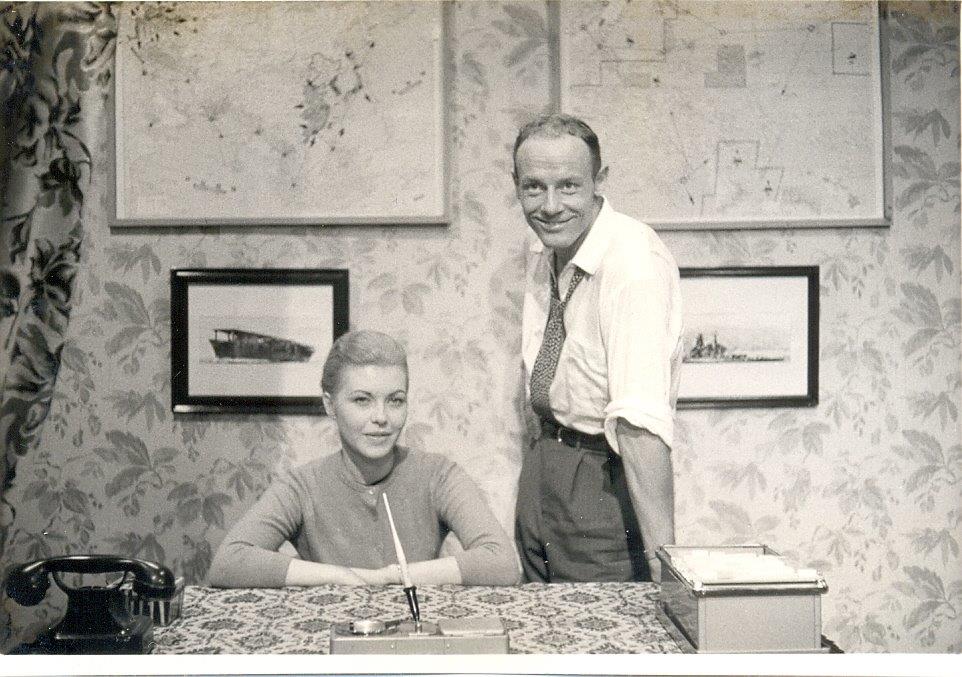
Heinz Bodmer on the set of Soviet Spy (1961) with Dona Carlson. Photo © Heinz Bodmer.
BH: What are your memories of Dona Carlson?
HB: We took a lot of jobs where we worked together. She was married to a civilian engineer with the American Air Force. The husband was stationed at an Air Force base outside of Tokyo – I can’t remember the name. She was probably about four or five years older than I. We spent some good times (together) when we had jobs where we were at some hotel which had a pool. There was a pool party in the movie. Things like that. We’d spend entire days basking in the sun and swimming in the pool, being in a couple of scenes here and there. As you probably know, often as an extra you’d be just sitting around, standing around, and nothing happens because you’re not in the scene until the director was ready to shoot that scene. Sometimes you’d go to the studio, and you’d do actually nothing, as far as work is concerned, and you’d come back the next day, and maybe there’s nothing again.
I’m remembering one movie where we were sent down to Kyoto. That was the spy movie, Who Are You, Mr. Sorge? (a.k.a. Soviet Spy, 1961). A German friend and I spent an entire week sailing on Lake Biwa because they were doing all the outside shots while the weather was good. Then, when the weather turned, they went to the studio, and that’s where my friend and I were in a couple of scenes. So we had a whole week, having a good time and getting paid, of course. Then we worked two days in the studio, and then they shipped us back to Tokyo.
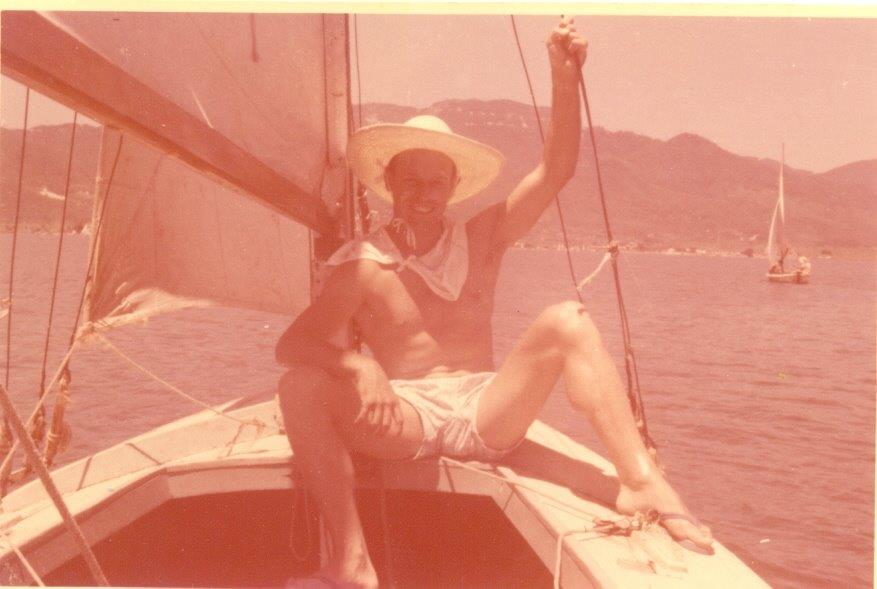
Sailing on Lake Biwa during the filming of Soviet Spy in Kyoto. Photo © Heinz Bodmer.
I went on location as far as Hokkaido. There was this one movie that was shot near Sapporo. We were Russian soldiers. They sent us on the overnight train to Sapporo. We spent a few days up there, then we traveled back again.
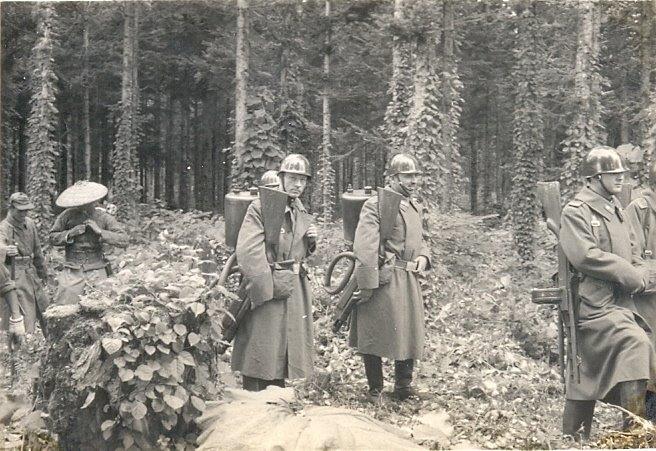
A location shoot in Hokkaido, playing a Russian soldier fighting the Chinese. Photo © Heinz Bodmer.
Of course, the biggest movie we were in was The Last Voyage (1960), which was shot on the former French flagship (Ile de) France, which was anchored outside Osaka Harbor (a.k.a. Osaka Bay). So we were sent down to Osaka, and we were put up in a hotel in Osaka. Then every morning a boat would take us out to the ship. Everything was shot on the ship. I believe probably 80 or 90% of the movie was all shot on the ship. It was a rather famous movie because, a few years later, I ended up in California. When I met my future wife on a blind date, she had a relative in California. The relative called one evening and said, “Switch on the television, channel so-and-so! I just saw Heinz in a movie called The Last Voyage!” (laughs) We’ve seen it on television several times. The main actors were Robert Stack, Dorothy Malone, and George Sanders. The only one still alive is Dorothy Malone; the other two have passed.
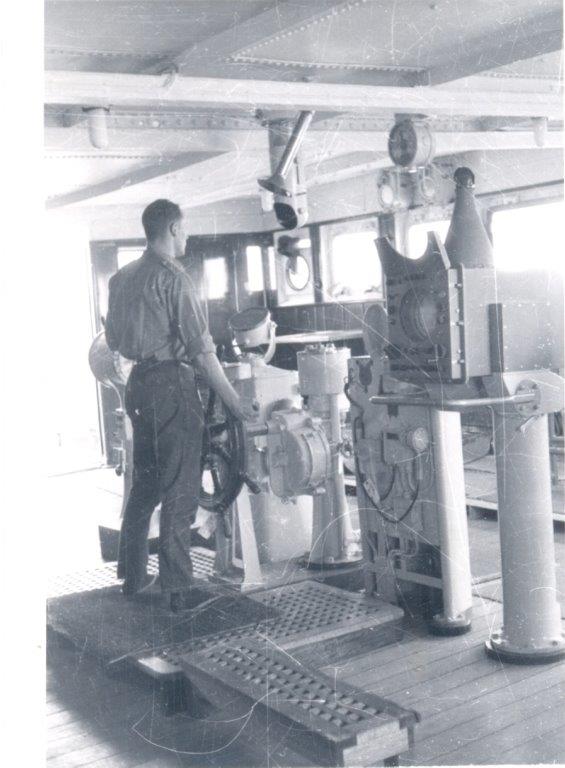
Mr. Bodmer “steers” the French flagship Ile de France in Osaka for The Last Voyage (1960). Photo © Heinz Bodmer.
BH: Did you get a chance to speak with Robert Stack, Dorothy Malone, or George Sanders during the film?
HB: Not really, no. Most of the time, the lead actors didn’t bother talking with mere extras. The only exception was one Japanese actor (Toshio Hosokawa) who was friendly. He liked to talk with foreigners. He was a great fan of Paul Anka. He lived near the karate school that I attended. He invited me over to his house once to show me all the memorabilia he had collected from Paul Anka. That’s the only time I actually had pretty good contact with a lead actor. Most of the time, they did not bother with mere extras. (laughs)
BH: Let’s switch gears, and let’s talk about Battle in Outer Space. Do you remember how you got cast in the film?
HB: We had to go to a big place – some big auditorium (where) there were several hundred people there, if I remember correctly. Out of everybody there, they picked whoever they wanted in the movie. I was one of the ones who got picked. I think it was the same place where, in the movie, the United Nations Assembly was held where they decided to build a United Nations force to fight those space beings.
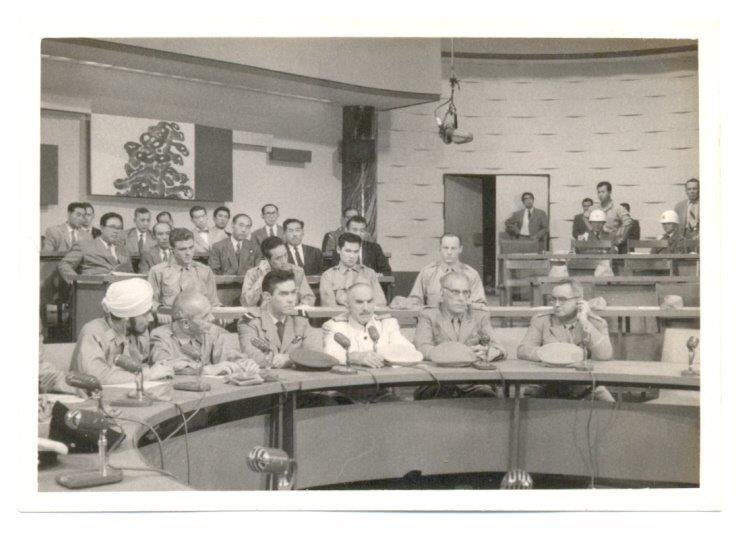
Heinz Bodmer, Ed Keane, and others contemplate the future of Earth. Photo © Heinz Bodmer. Battle in Outer Space © 1959, Toho Co., Ltd.
BH: After you were cast, do you remember what the next step was? Were you fitted for your costume?
HB: The uniforms, of course, and the spacesuits and everything. We were fitted for all that. I’ve forgotten really how long, but I think there was probably about three weeks’ worth of work involved for most of the extras in that movie.
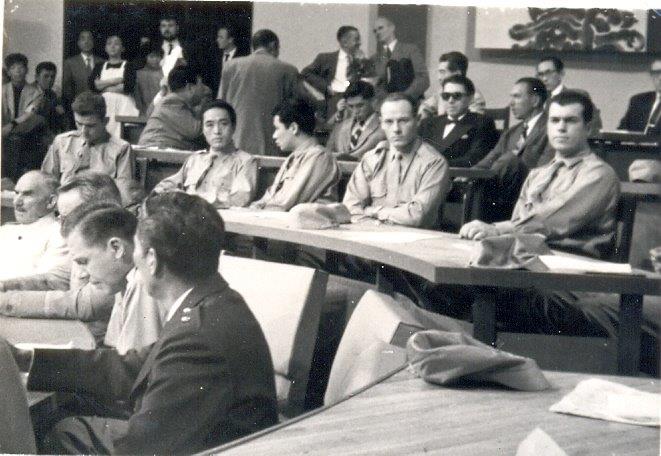
Heinz Bodmer shows the camera his resolve as the world faces the threat of annihilation. Photo © Heinz Bodmer. Battle in Outer Space © 1959, Toho Co., Ltd.
BH: Was there any time for rehearsals?
HB: No, not really, because I didn’t have a speaking part or anything. They just would tell you where to go, where to stand, where to move. It was pretty basic.
BH: Do you remember how many takes there were generally?
HB: No, I don’t remember that. Again, some days you just sit around, and you were in no takes. Other times, you were in several. It just depended on the situation and on the director. Sometimes the director would shoot takes after takes after takes of one scene until he finally liked it. Then they finally took the final take. Sometimes it happened that in the final take the lead actor would forget the lines, and they’d have to start all over again! (laughs)
BH: What do you remember about the director, Ishiro Honda?
HB: Nothing, really. Even the name does not ring a bell anymore. Often we didn’t even bother with the names of people. We’d just sit around, stand around, talk around, and whenever they called us and said, “You have to go in now,” or “You go there now,” or “You climb into this vehicle,” you just followed orders. But you didn’t really have much contact. Even the directors didn’t have more contact with the extras than they actually had to.
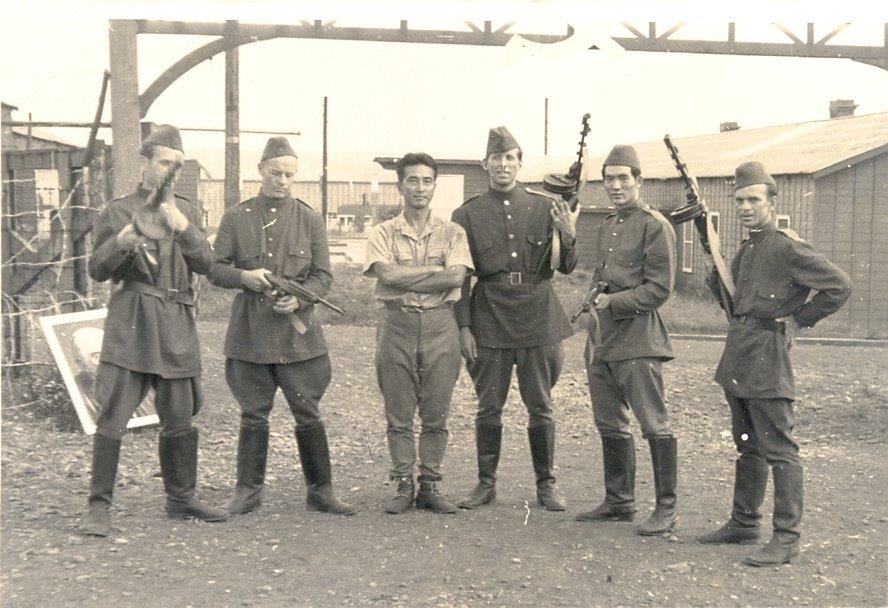
Heinz Bodmer (second from the left) and William Ross (fourth from the left) play Russian soldiers halfway up Mt. Fuji on a former military base. Photo © Heinz Bodmer.
BH: Was Johnny Yusuf your main contact on the film, or was it Bill Ross? Do you remember?
HB: Generally, Yusuf was. (I remember Bill Ross being an extra). Especially in the beginning, when my Japanese was still very basic, he would of course translate. The director would tell him to tell the extras what to do. Then he would tell us what to do, where to stand, and whatever.
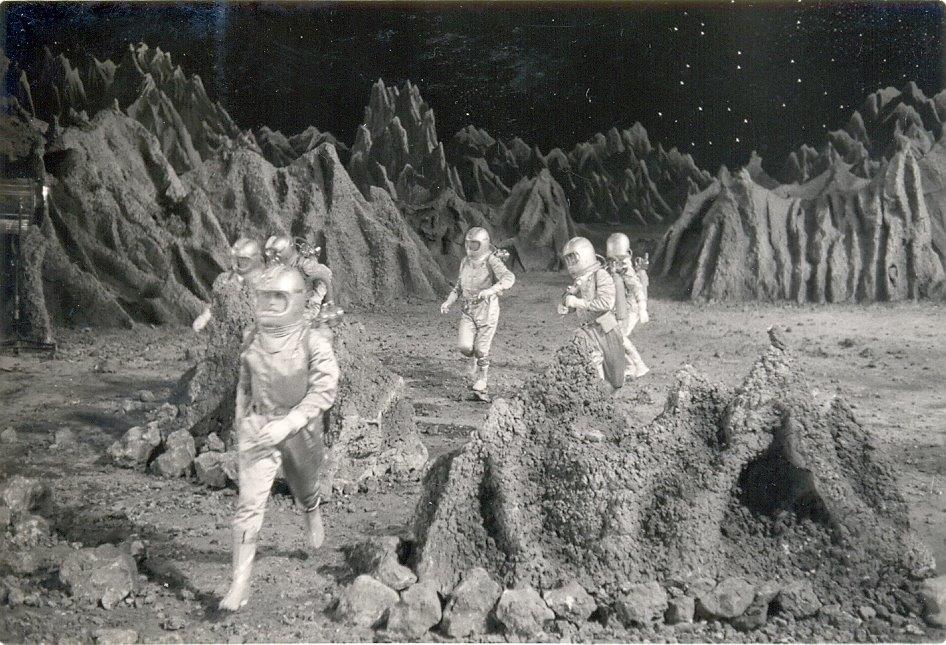
The SPIP crew prepares for battle on the Moon. Photo © Heinz Bodmer. Battle in Outer Space © 1959, Toho Co., Ltd.
BH: What do you remember about some of the other foreign talent who were, such as Elise Richter, George Whyman, some of the other folks who were there with you?
HB: I vaguely remember George Whyman being an extra in one of the movies. Elise Richter I remember well. I have photos of her and I being in a photo shoot for a Panasonic Christmas catalog. The first shots were made in a private residence which was decorated for Christmas (in August), and the second shots were taken on location in a rowboat on Lake Hakone (a.k.a. Lake Ashi). Of course, she also was a crew member on the space ship in Battle in Outer Space. I have a picture of her reclining in the seat in front of mine inside the spaceship.
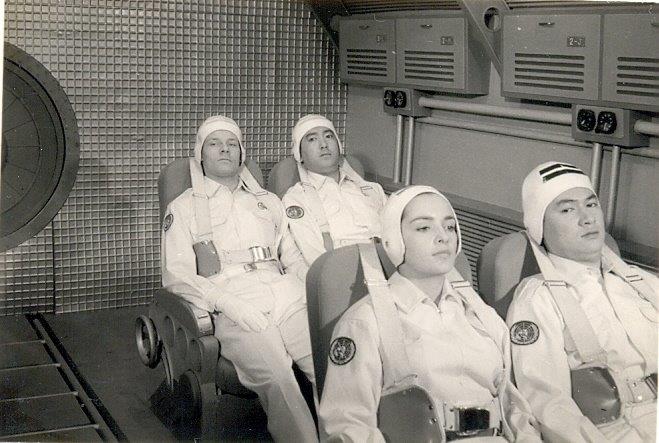
When they weren’t saving the world, Elise Richter (in the front) and Heinz Bodmer worked together on a photo shoot for a Panasonic Christmas catalog. Photo © Heinz Bodmer. Battle in Outer Space © 1959, Toho Co., Ltd.
In that particular movie, there was one guy who actually had a speaking part, an American who had a speaking part. I think his speaking part was mainly inside the (space)ship. I can’t remember his name. I just remember that the Japanese girls there all would look at him, get together, and they’d whisper into each other’s ears, saying he looks like Clark Gable. (laughs) He looked so much like Clark Gable, and obviously a lot of Japanese girls knew Clark Gable from the pictures that they saw. You know how Japanese girls cover their mouths and then giggle? Well, they did that about “Clark Gable”! (laughs) So I remember him, but I don’t remember his name. I’m sure you would probably recognize him. He looks a lot like Clark Gable. Was it, maybe, Pearce? Last name Pearce, or something like that.
BH: Malcolm Pearce?
HB: Malcolm Pearce, that’s the guy. (laughs)
BH: There’s a Leonard Walsh (a.k.a Leonard Walch)…
HB: I remember Walsh – just the name, basically. Nothing specific to that movie. I don’t remember anything specific, just Pearce. I know that he had a speaking part as we were inside the (space)ship.
BH: Were those girls working on the film? Were they other actresses, or were they just spectators?
HB: Spectators and Japanese extras, basically.
BH: What do you remember about some of the sets that were used, such as the Moon and the spaceship?
HB: That, of course, was pretty much new to me, such intricate kind of sets in the studio. Playing astronaut on the Moon, that of course was interesting. Today, this would be nothing because people have been there. But at that time, this was all science fiction. Of course, all that seems now Neanderthal because science has overtaken that fiction, made that fiction come true, in many ways, again and again, in a much more advanced fashion. When I look at the movie, which I actually have on DVD, I laugh sometimes. I’d say, “Boy, this is so Neanderthal!” But, back then, it was science fiction. It was very interesting. So, of course, the movie sets were interesting.
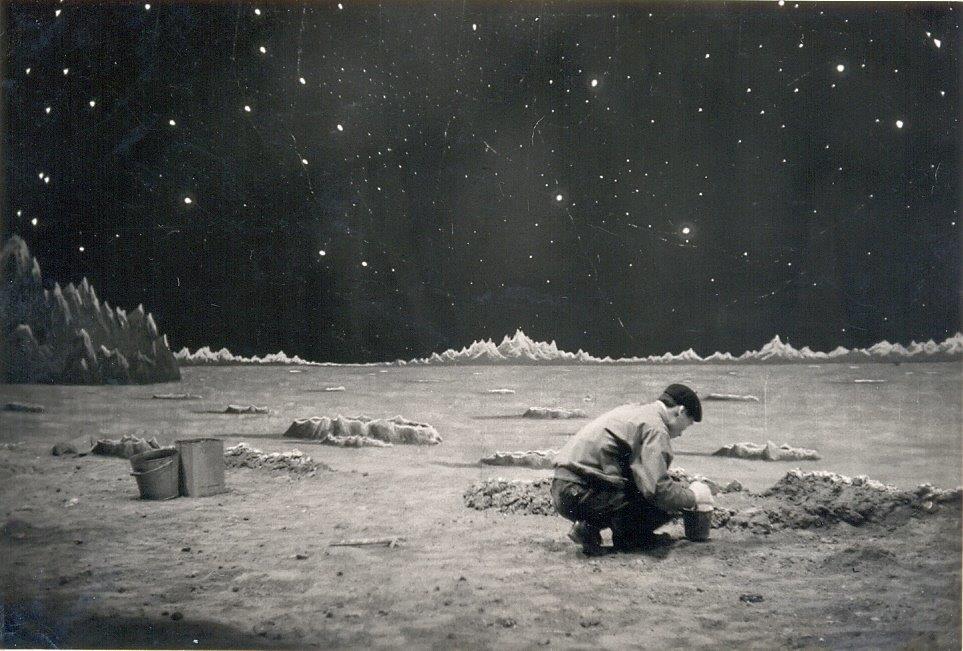
Toho’s hardworking crew gives its audience a Moon with a view. Photo © Heinz Bodmer. Battle in Outer Space © 1959, Toho Co., Ltd.
BH: Do you have any other interesting memories from Battle in Outer Space?
HB: No, not really. Not really. There were some extras that had ambitions for being in the movies. For me, it was just an income. But then, it was fun, and I met a lot of people. I met people from many places. They were Americans, British, Canadians, Australians, Europeans from different countries – France, Germany, even another Swiss I met. I met a lot of people, and I met a lot of girls, which was even better yet! So it was an interesting job, but basically I was in it for the money, period.
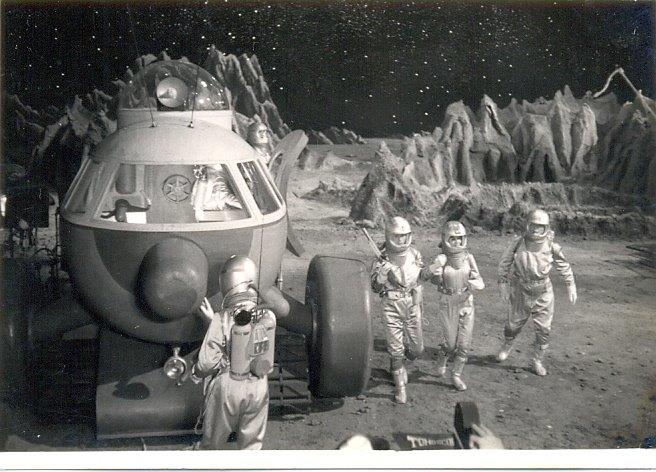
The SPIP crew springs into action in this dynamic behind-the-scenes shot. Photo © Heinz Bodmer. Battle in Outer Space © 1959, Toho Co., Ltd.
HB: Do you have any general memories of Toho Studios?
HB: Toho was the nicest – I believe it was the biggest. It had a nice restaurant. We’d come in in the morning and have breakfast. Later on, we’d have lunch there. Some of the other studios like Nikkatsu and Shintoho, they were not as big or as nice. Of course, I remember the days where we were in the studio all day long. It was cold, and we’d be freezing in there. We’d order hot soba, and slurp it down as fast as we could to warm ourselves up from the inside. Studios didn’t have any heating. The temperature was whatever it happened to be. Sometimes in winter it was pretty cold.
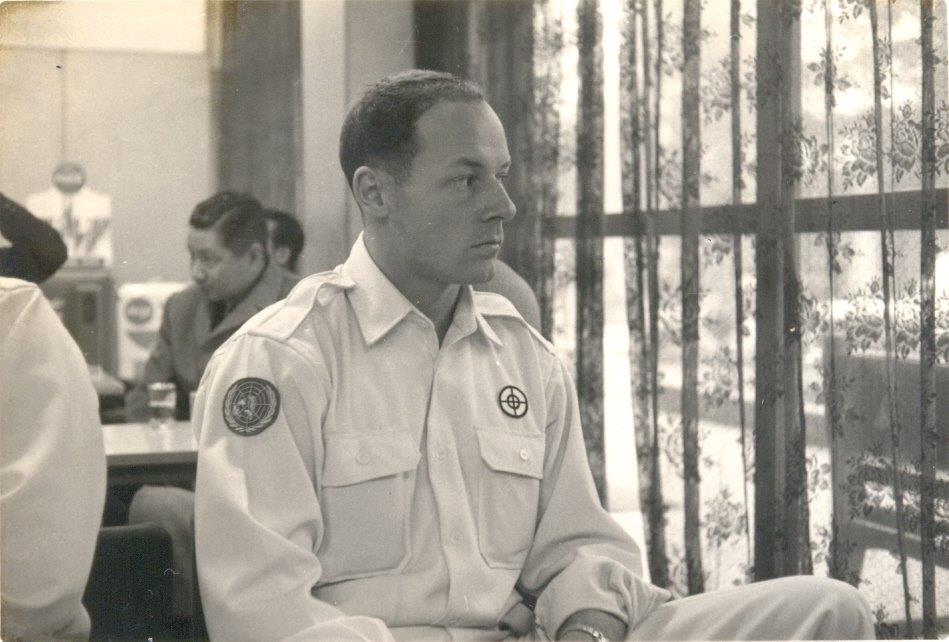
After battling aliens on the Moon, Mr. Bodmer takes a break in the Toho commissary. Photo © Heinz Bodmer. Battle in Outer Space © 1959, Toho Co., Ltd.
BH: How would you describe Toho for someone who was not there at the time? Now it is a very different studio.
HB: I had never been in a movie studio prior to being an extra, so all I had to compare was one studio with the other. I could compare Toho to Nikkatsu to Shintoho. All I can say is, Toho was the nicest, seemed to be the most modern at that time.
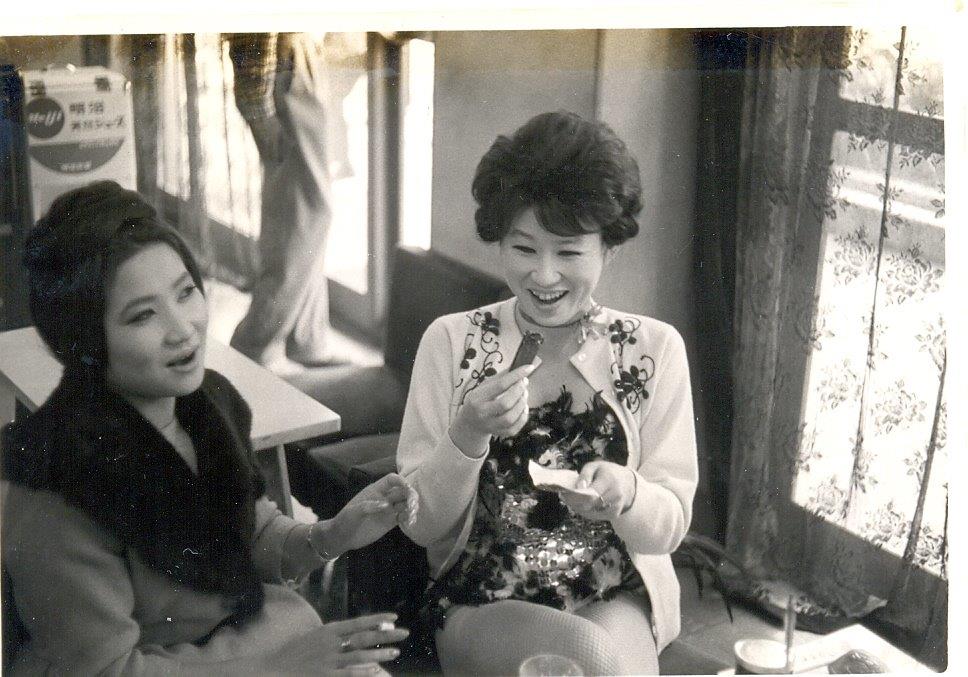
Actress Noriko Shigeyama (right) chats with a colleague in the Toho commissary. Photo © Heinz Bodmer.
BH: Specifically talking about Nikkatsu and Shintoho, what was it like going to work for those studios?
HB: Those studios were just a bit on the primitive side, it seemed. I don’t even recall that either one of them had a restaurant or a coffee shop or anything like that. Toho had all that. Basically a big warehouse — that’s how I remember those other studios. It was always a treat to go to Toho, to be called to go to Toho rather than the others.
BH: Do you remember any major difference between Nikkatsu and Shintoho?
HB: Not really.
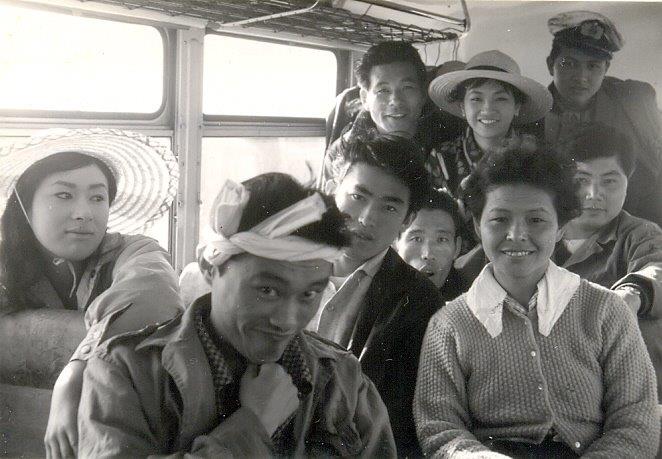
On location in Chiba Prefecture for a Nikkatsu film. Photo © Heinz Bodmer.
BH: About the movie Watashi wa kai ni naritai (a.k.a. I Want to Be a Shellfish, 1959), in which you play the injured airman, what memories do you have of that role?
HB: I think it was a former United States Marine base. There was this big open field, and on the sides of it there were trees, and there were enormous rocks, boulders. Obviously the open field was prepared with some, I guess, firecrackers. They were to go off as the actual United States Air Force fighter planes flew over and were strafing that whole area, strafing Japanese soldiers. As the planes flew over, these firecrackers would go off, making it seem as if the fighter planes were actually strafing the area, killing Japanese soldiers.
Obviously there were supposed to be no American soldiers in that area. Before that happened, they told all of us to go hide behind those big boulders and not come out. But that American guy – and I don’t remember his name – he was already behind the boulders, sleeping off a tremendous hangover. When that noise from the planes and the firecrackers all of a sudden started, he got woken up out of his stupor, he jumped up and ran out onto the open field where there were supposed to be no GIs! So the company obviously had to redo that whole scene and pay again for the U.S. Air Force to fly over. So the guy got blacklisted; he was never going to be an extra in any Japanese movie company ever again. That was the big memory I have of that particular movie.
Other than that, of course, we enjoyed all that makeup they put on us! The way we looked, it was interesting to take some pictures. The guy holding me up in one picture, that was Don Droeger, who I mentioned before. He was the American who had asked me whether I wanted to make money and so introduced me to Keane. Of course, Don Droeger was quite a bit older than I, and I was able Google him, and I found out when he died. But he was a cool guy. (laughs) If it wasn’t for him, then maybe I would have never been an extra, and I would have never been able to make all that extra money, enabling me to stay longer in Japan.
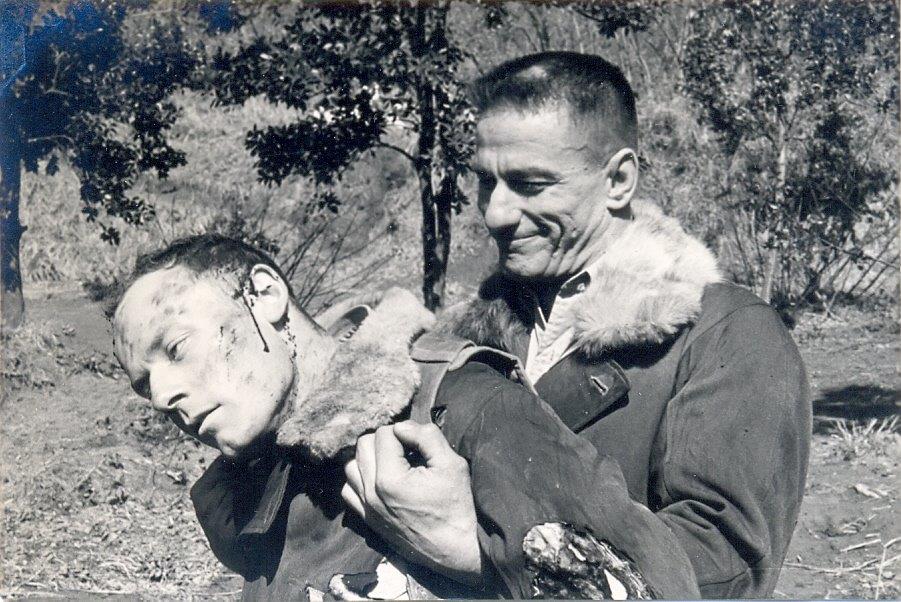
Playing an injured American airman in I Want to Be a Shellfish, along with Don Droeger. Photo © Heinz Bodmer. I Want to Be a Shellfish © 1959, Toho Co., Ltd.
At that time, it was 360 yen to a dollar. For 300 yen, I was able to get three square meals a day – for less than a dollar. For the three years’ time that I was there – a little under three years – I spent an average of about 32,000 yen a month, which was less than $100 a month. It included everything. It included lodging, food, clothing, transportation, tuition, and fun – 32,000 yen average per month during those three years. It was a great deal then, definitely. When I got a two-, three-week stint in a movie, two to three weeks’ pay would last me two to three months. That’s how I was able to stay there for almost three years and never touch my savings. (laughs)
BH: Do you have any other memories, before we continue, about working on any films or any movie personalities that you’d like to share?
HB: That one film where we went on location to the Izu Peninsula, we went by bus. I was the only foreigner, the only foreign extra in that movie. I remember when we got there, it was about dinnertime, and all the Japanese extras, and even some of the lesser actors, they wanted to kampai with the foreigner! That was all before dinner. Between sake and beer, by the time dinner came around, I was pretty well done in. The next two days, I was sick. I was actually sick. I had diarrhea from all that booze. So the rest of that location stay was not much of a picnic. (laughs) That’s how things go. Sometimes you have a good time, and sometimes you don’t.
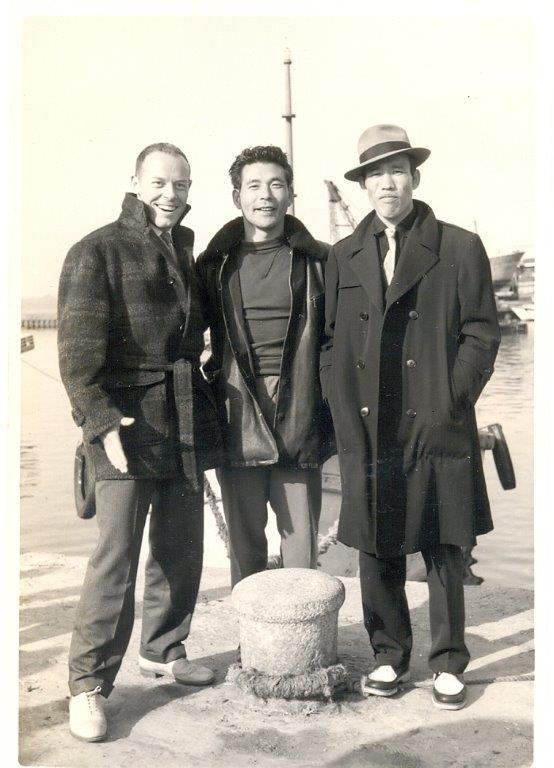
Mr. Bodmer found himself a bit too popular on location in Chiba for Nikkatsu. Photo © Heinz Bodmer.
Sometimes going on location was fun, like in Kyoto where we got to sail for almost a week before we were actually called to work. In the meantime, we were paid for every day. Well, it was similar with The Last Voyage when we were put up in hotels in Osaka, and every day we were shipped out to the big ship. Obviously whenever we got back to Osaka, we’d go out and party. Then, when we got back to the ship the next day, there were a lot of state rooms in that ship. Everybody would find a state room and go to sleep, except for the ones who were very eager to be in scenes. There were always two kinds of people: Those who just came there for the money, and I was one of them, and then there were the ones that had ambitions to become actors, and they wanted to have their face in every scene possible. Of course, in that ship, I was a crew member, assigned to the boiler room way down in the ship. They actually flooded the whole boiler room, and I made sure I wasn’t going to be there. I didn’t want to be in that disgusting, oily seawater. So I, as well as many others, went to sleep in some state room a few decks further up. The ones that were down below, they were called up to be here, be there, and do this scene, and that scene. The ones who weren’t there, well, there were so many people there that they couldn’t keep track of everybody. Like I say, I think it was a three-week deal — three weeks of partying at night and sleeping during the day, and once in a while being in a scene in between! Filming on location was always nice because I was able to see many different parts of Japan without having to pay for transportation.
BH: Ultimately you left Japan because the visa ran out?
HB: Yes, because the visa ran out, and I didn’t want to just go out and then come back in, and I really wanted to go on. Actually, I made the decision on the way to Japan that I was not going to go back the same way. I was somewhere in the Indian Ocean, and I was just overwhelmed (by) what I was doing – that long, 33-day cruise. I said to myself, “Gee, was I ever stupid! Why did I get a round-trip ticket? Why would I want to go back the same way?”
So one of the first things I did when I got to Japan, I went to the shipping company (Messageries Maritimes), and I sold the return part of the ticket back. I put that money in the bank, and I decided that whenever I’d be ready to go back to Switzerland, I would find another route. In the back of my mind was that maybe I’d go to Hokkaido and then over to the Kamchatka Peninsula and somehow catch the Orient Express. In the back of my mind, I thought maybe that might be my return way, that’s how I’d go back to Switzerland. But then of course that changed, and I decided that I would not be going back to Switzerland. I’d keep going east. I went across the Pacific on an immigrant ship that was bringing Japanese immigrants to Brazil. We landed in San Pedro, California, and that’s where I got off, while all the Japanese migrants stayed on the same ship, eventually going through the Suez Canal and down to Brazil.
BH: Of course, you went on and eventually ended up in the U.S.
HB: I only had a transit visa, which allowed me to stay in the U.S. for a limited time. I had met a Mexican man in the judo school in Tokyo, who took a liking to me because I had spent some time with him, teaching him a few things. He said, “If you ever come to Mexico, look me up.” So I decided I was going to go to Mexico. The reason I was going to Mexico was I was not quite 26 yet, and I was told by Americans that if I was under the age of 26, and I’d go to the United States as an immigrant, they would draft me and send me to Vietnam. I didn’t want that, so I decided I was going to go to Mexico and wait until I was 26, then migrate to the United States.
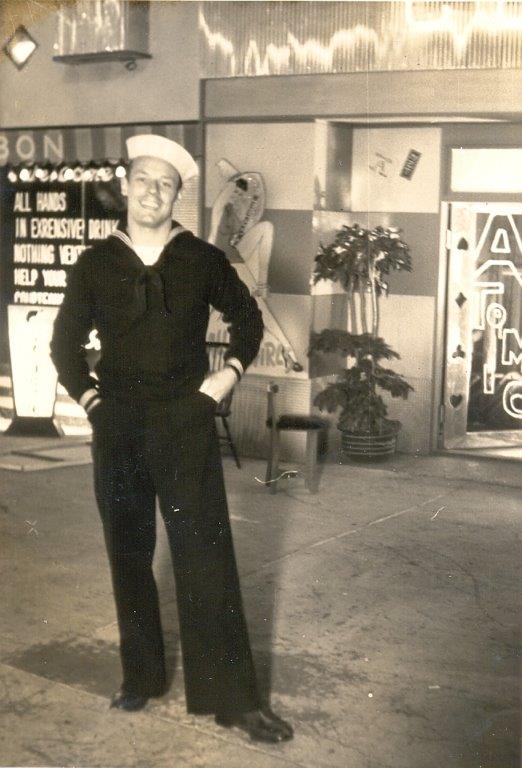
Playing an American sailor. Photo © Heinz Bodmer.
So eventually I went to Mexico City and gave that guy a ring and found out that he was the jefe de production (chief of production) at the Televicentro in Mexico City. He then got me in touch with some judo schools and judo teachers, and I was teaching judo and karate in those schools – especially karate because there wasn’t much of that in Mexico at that time. That’s how I made a living. He also introduced me to a Cuban/Chinese who had a judo school and a judo television program. He invited me on several times as a guest to demonstrate karate. Eventually I went to Guadalajara and opened a martial arts school in Guadalajara, Mexico. The brother of my friend in Mexico City arranged for me to have my own martial arts television show. He was jefe de production at the Televicentro in Guadalajara. Every Saturday morning, I did a show, consisting of 15 minutes of judo and 15 minutes of karate. Of course, I already knew my way around studios. I even wrote my own scripts for the shows in Spanish. It was quite easy for me to pick up Spanish since I already knew Italian, which is rather similar. Later on, I got into some problems with immigration because the immigration office didn’t want to renew my working permit.
So I ended up in Costa Rica where I knew another martial arts guy that I had met in Japan. I was teaching karate and judo down there. I tried in Costa Rica at the Mexican embassy to get new working papers to go back to teach in Guadalajara, but I didn’t succeed. So I went back to Guadalajara. At that time, my lawyer told me that they were preparing to deport me because I was working without a permit. (laughs) The last place I wanted to go was Switzerland, and that’s where they would have sent me. So I was able to get a tourist visa to go to California. I beat them to the punch; I got out of Guadalajara before they came to get me and send me back to Switzerland. I got to California where on a blind date I met what two years later would become my wife. After we got married, she and I went to Europe and finished my circle around the globe, which was eight years after I had left. So it took me eight years to get once around the globe. (laughs). We spent six weeks in Europe, touring all over, showing my wife off to my parents and relatives. Then we went back to California. All together, we were there seven years. Then we moved to Florida. We have been here ever since. We raised two beautiful daughters who eventually gave us three granddaughters.
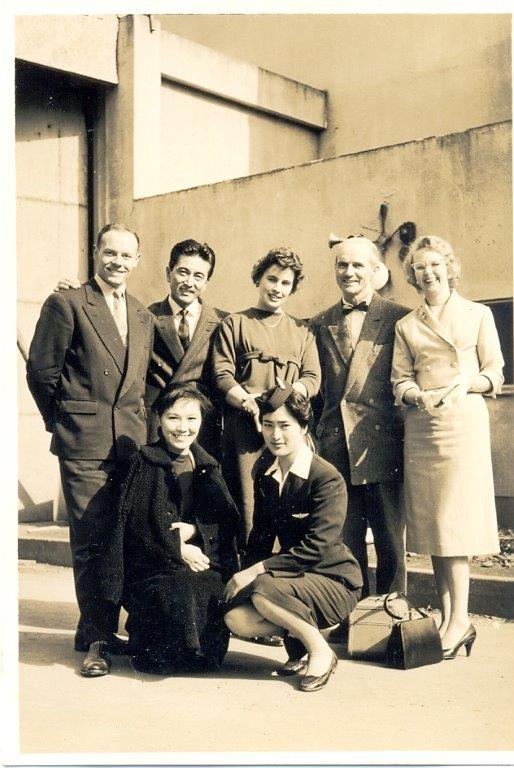
Heinz Bodmer (on the far left) and Andrew Hughes (second from the right) pose with Shintoho star Toshio Hosokawa (second from the left) on the set of Teiso no Arashi (1959). Photo © Heinz Bodmer.
In Southern California, I worked as a precision machinist in the aerospace industry. In Florida, I opened my own precision machine shop where we produced precision components for the aerospace industry. Many of those components ended up in real space (as opposed to the science fiction space) as well as on the real Moon, in rockets, satellites, and the (now retired) space shuttle. Of course, I retired several years ago. Last year we just celebrated our 50th wedding anniversary, my wife’s 70th birthday, and my 80th, and we also went to Tahiti for a nice vacation. But I never made it to real outer space or to the real Moon! (laughs)
Disclaimer: The pictures contained in this article are the exclusive property of Mr. Heinz Bodmer, as they were shot with his own camera during his years in Japan. These pictures may not be reproduced without permission.
I truly enjoy the interview, you have a very interesting and wonderful life, thank you very much for the email.
Sr. Vivian
LikeLiked by 1 person
Eventhough I had seen the films with my brother Heinz acting in them, once upon the time visitng him and his family in Florida, I enjoyed the above interview very much. In ocasions I send it to English speaking friends all over the world.
Heidi Neumeier-Bodmer
LikeLiked by 1 person